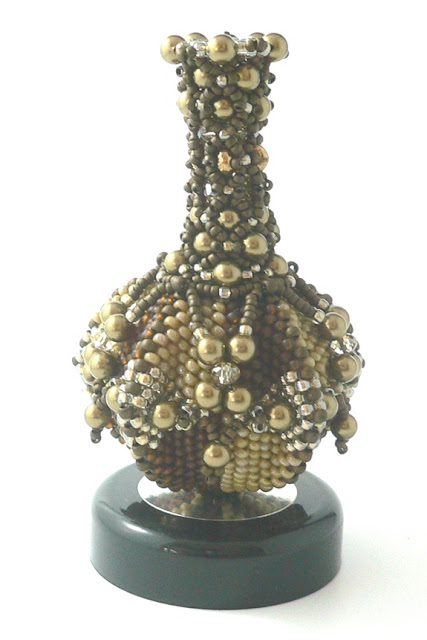As promised I’m musing in my blogs over the next few weeks on the criteria used to judge beadwork in contemporary beading competitions and challenges. This week I’m musing on ‘
originality’. What is it, how do we create it in beadwork and why is it valued so much?
Dictionaries tell me that an original object is something that is a new, one-of-a-kind object. It is not a copy, imitation, facsimile, clone or forgery. It begins (originates) with an individual who independently of others uses their own ideas and skills to create something unique.
Sounds simple, doesn’t it? However, like many things in our social world, the simple is often more complex, than it is simple.
To claim that we have created something truly original in any creative endeavour, such as beadwork, (unique) is tricky business. Our ideas shape and reshape as we talk with others, read, look and listen to what others think and say and learn from others how to do new things. Our own ideas and skills are enmeshed with the ideas and skills of those we learn from. Where does one person’s idea start and another’s end? Where are the boundaries that make it possible to say, ‘This is my original idea, design or creation? I did this? This is new.’. How can we claim originality in our beadwork when all beadwork shares a common heritage of ‘how to’ weave, string and shape little objects with holes in them together. Some beaders learn these techniques by reading books, looking at patterns, attending classes and/or having beading buddies that show us ‘ how to’. Amongst this learning and sharing where are the boundaries of originality?
 |
| Blue beaded beads by Glenda of Dax Designs Bead Art: an original or not? |
Originality can never be found in what others have done before us – the dictionary tells us that. So, if someone did it before you did it – then your beadwork is not original. This means that much of what we create as beaders isn't original. For instance, many of the beadweaving stitches (e.g. Ndebele, Peyote, Netting, etc.) and techniques (e.g. stringing, embroidery) we use in our beadwork have been done before us. However, what we can do differently is use those stitches and techniques to create something that others have not done in the way that we have done it. We can do this by using design elements of colour, shape, space, texture, size, line and direction in imaginative and daring new ways. In our designs originality lies in how we balance each of these elements. For instance, how we use the repetitions or gradations of colour tones or shapes to create harmony, what we choose to have as the dominant design element and how we balance that with the lines in the piece.
A key question to ask if we are musing on the originality of our work is, ‘Was it done this way, before I did it?’. From this, you can form more specific questions such as: 'Have others used colour in this way in their bead embroidery? Have others combined shapes and colours in the way I have in making a beaded bead? Have others created texture in the ways I am doing it in this peyote cuff?'. Your originality will be judged by how these questions are answered.
Play with doing what has not been done before using my
Originality musings matrix below. Take a design you think is original and see what words best describe it - some words that invoke originality you could use are: bold, daring, fresh, unusual, inventive, non-conforming, unorthodox, novel …. . Phrases like, 'This reminds me of...', 'I've seen something like this in...' and 'Been there, done that...' suggest a piece lacks originality.
 |
| Originality musings matrix by Glenda of Dax Designs Bead Art |
Amongst the quest for originality, you might muse on the idea that originality is a relativity new quest in Western European cultures. Prior to the 18th century, to imitate was to show that you understood and appreciated what went before you. Artists, writers and musicians sought to emulate what went before them as a way of bringing excellence into their own work. For instance, Shakespeare is attributed with saying he valued "unnecessary invention". For more on this, see Koen de Winter –
Thoughts on originality (
link here).
I'd love to hear what you think? What musings do you have that are original about originality?









































